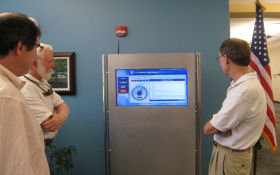Students Learn From Sustainability
 Educators often talk about teachable moments — opportunities to encourage students to think critically about and learn from a current event or issue.
Educators often talk about teachable moments — opportunities to encourage students to think critically about and learn from a current event or issue. When planning a sustainable school, educators and designers can develop a high-performance building that not only achieves LEED Silver, Gold, or Platinum certification but also generates learning opportunities in a wide range of curricula, including math, science, information technology, social studies and environmental education.
Key factors in achieving these dual goals are a committed owner and project team, an integrated design process, an understanding of the fundamentals of sustainability and the incorporation of visible design features and energy and water measurement devices that display data for students to see and use.
A Committed Team
When planning a high-performance building with opportunities for learning, the owner should assemble a core team of school leaders, teachers and building managers who are committed to attaining these goals.
A project team should be selected based on a demonstrated passion for sustainability and real-world experience with sustainable school planning, design and construction.
The most successful projects also have a sustainable design champion on the owner’s team and the project team. On the owner’s side, the champion may be the superintendent or a member of the school board — a person who can elicit the enthusiasm and support of the stakeholders, including the board and community. On the project team’s side of the table, the sustainability champion is usually a member of the architectural or engineering team, who often is the LEED administrator.
The most successful sustainable school projects use LEED as a qualitative guideline for discussion of planning, design and construction issues, rather than as a simple quantitative checklist for chasing LEED certification points.
In the right hands, the LEED for Schools Reference Guide becomes a framework for discussion of the critically important sustainability issues and helps the owner and project team to define the characteristics and features of a high-performance building.
An Integrated Process
The most successful projects also use an integrated design process to achieve a sustainably designed school building that fulfills the owner’s educational mission and program.
Traditionally, project teams hand off the design in a linear fashion from one member to another. The owner defines the educational program; the architect defines the size, shape and overall aesthetic of the building; the structural engineer determines the most cost-effective structural form; the mechanical, electrical and plumbing engineers design systems to supply and operate the building; and finally, the team hands off completed, approved construction drawings to the builder.
But the problem with the use of a linear design process on a sustainable school building is that a sustainable feature might be derailed anywhere along the line if one member decides that it won’t work.
In contrast, an integrated design team brings all of the design, engineering and construction disciplines to the table to find solutions that work.
For example, when a cistern was proposed to collect stormwater at a new high school, the entire team identified the ideal location of the cistern and uses for the collected water. Not only was this a sustainable, cost-effective design solution, it also qualified for nine LEED points and helped develop related science lessons.
Visible Features
Incorporation of visible features of sustainability and energy and water measurement devices that display data for students to see and use are essential to development of curricula related to the features of the sustainable school building.
Let students see a green roof, waterless urinals and other water-saving plumbing fixtures, abundant daylight and views of the outdoors. Install instruments that measure water and energy usage and display them in a public place, such as the lobby or student commons, and on a dedicated school Web page.
Involve teachers, curriculum specialists and the project team’s LEED-accredited professional in developing lessons that use the features and data generated by the sustainable building.
In addition to benefiting students, the LEED rating system offers a design innovation point for educational outreach.
Today, a high-performance school building has an additional meaning beyond efficient use of resources, lower life-cycle operating costs and enhanced user health and comfort. It is a building that teaches.
Bryna Dunn, AICP, LEED AP, is vice president and director of environmental planning and research at Moseley Architects in Richmond, Va. Contact her at bdunn@moseleyarchitects.com.
